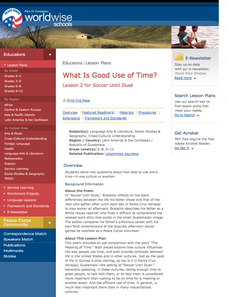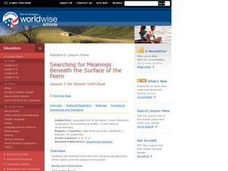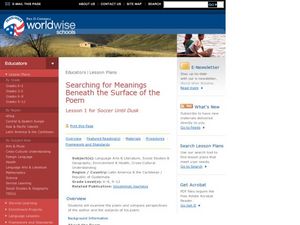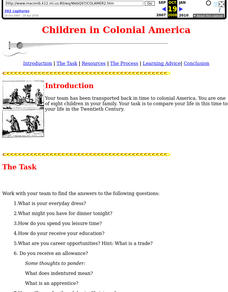Curated OER
What is Good Use of Time?
Students analyze the best uses of time in other cultures. In this time use lesson, students read the poem 'Soccer Into Dusk' and 'The Meaning of Time' as analysis of time usage in other culttures. Students complete a discussion, journal...
Curated OER
Work and Leisure
First graders distinguish between work and leisure activities, identify examples of people participating in each of these types of activities, and put them in the correct category.
Curated OER
What Is Good Use of Time?
Students delve into questions about how best to use one's time-in one culture or another. They explore the kinds of choices students will make about their use of time and consider the statement: "We are shaped by the values of the...
Curated OER
Searching for Meanings Benath the Surface of the Poem
Learners read "Soccer Until Dusk". As a class, they discuss the various settings and actions in the poem and discuss the life in Guatemala and compare it with the United States. To end the lesson, they complete a journal reflection...
Curated OER
Searching for Meanings Beneath the Surface of the Poem
Students examine poems from Latin America and the Caribbean. They compare different perspectives and subjects in the poems. They research Peace Corps volunteers as well.
Curated OER
Searching for Meanings Beneath the Surface of the Poem
Young scholars analyze poetry. In this cultural perspectives instructional activity, students read the poem "Soccer Until Dusk" by Mark Brazaitis. Young scholars analyze the poem and consider the cultural perspective it reveals.
Curated OER
Workin' (More Than) 9 to 5
Students explore the roles of men and women in the work force. They explore how each one should balance family life. They develop questions that are about men and women and how they perceive their roles at work, home and in leisure...
Curated OER
Turn Off the TV?
Classroom ideas that provide opportunities for pupils to explore alternative leisure activities during National TV-Turnoff Week.
Curated OER
That's Entertainment
Second graders view examples of active lifestyles in works of Robert Harris, and list and graph their daily activities to see if they lead active lifestyles. Students then name forms of entertainment that require practice,...
Curated OER
A Day in the Life: Studying Ancient Rome
Class members use their knowledge of Ancient Rome to write articles for an online newspaper. Using WebBlender, learners craft articles that feature Roman politics, culture, and leisure activities.
Curated OER
Children in Colonial America
Students, in teams, race to find answers to questions about Colonial America using the Internet and print sources. They make charts that compare and contrast colonial times with the present.
Curated OER
Social Inequality 2
In this sociology worksheet, students identify types of work, define 3 terms, identify leisure activities, and answer 4 short answer questions as they evaluate work in modern day society.
Curated OER
Lessons from the Holocaust
Students discover what a dictatorship is by examining the holocaust. In this government lesson, students discuss the laws that were enacted for Nazis to take control of Germany, and the types of laws we have put place to prevent...
Curated OER
1900 America: Historical Voices, Poetic Visions
High schoolers examine the United States at the turn of the century. Using primary source documents, they interpret them within a specific historical context. Using this information, they write a poem with metaphors and a specific meter...
Curated OER
Ukiyo-e
Pupils investigate and examine ukiyo-e, or Japanese woodblock prints, from the Edo period (1615-1868) in Japan and use this gained knowledge to compare Japanese culture to American societal trends.
Curated OER
Would You Live Common Law?
Students explore common law. In this sociology instructional activity, students discover what constitutes common law unions in Canada and then discuss how common law relationships compare to marriages.
Curated OER
Primary Sources
Students write personal facts on a photograph of themselves to create a Primary Source. They then define Primary Source and list examples as a class of places where they could find primary sources. They also discuss the importance of...
















